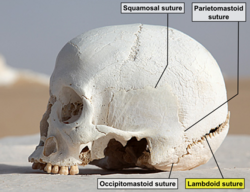| Lambdoid suture | |
|---|---|
 Lambdoid suture (shown in red line) | |
 Lambdoid suture (labeled at bottom right) | |
| Details | |
| Part of | skull |
| Nerve | supraorbital nerve |
| Identifiers | |
| Latin | sutura lambdoidea |
| TA98 | A03.1.02.004 |
| TA2 | 1577 |
| FMA | 52933 |
| Anatomical terms of bone | |
The lambdoid suture (or lambdoidal suture) is a dense, fibrous connective tissue joint on the posterior aspect of the skull that connects the parietal bones with the occipital bone. It is continuous with the occipitomastoid suture.
YouTube Encyclopedic
-
1/3Views:20 5461 2541 356
-
External Skull Anatomy - Osteology Study Aid and Quiz
-
Picture tests in head and neck anatomy 10
-
Medicine - The Occipital Bone
Transcription
Structure
The lambdoid suture is between the paired parietal bones and the occipital bone of the skull. It runs from the asterion on each side.
Nerve supply
The lambdoid suture may be supplied by a branch of the supraorbital nerve, a branch of the frontal branch of the trigeminal nerve.[1][2]
Clinical significance
At birth, the bones of the skull do not meet. If certain bones of the skull grow too fast, then craniosynostosis (premature closure of the sutures) may occur. This can result in skull deformities. If the lambdoid suture closes too soon on one side, the skull will appear twisted and asymmetrical, a condition called "plagiocephaly". Plagiocephaly refers to the shape and not the condition. The condition is craniosynostosis.[citation needed]
The lambdoid suture can be damaged by a fall backward.[2]
Etymology
The lambdoid suture is named due to its uppercase lambda-like shape.
Additional images
-
Animation. Lambdoid suture shown in red.
-
Parietal bones (above) and occipital bone (below).
-
Skull seen from behind. Showing Λ-like shape of the lambdoid suture.
-
Lambdoid suture seen from above.
-
Lambdoid suture seen from inside.
-
Lambdoid suture, medial view. Indicated by yellow line.
-
Lambdoid suture with Wormian bones, seen from behind.
References
- ^ Barral, Jean-Pierre; Croibier, Alain (2009-01-01). "2 - Characteristics of cranial nerves". Manual Therapy for the Cranial Nerves. Churchill Livingstone. pp. 7–14. doi:10.1016/b978-0-7020-3100-7.50005-7. ISBN 978-0-7020-3100-7.
{{cite book}}: CS1 maint: date and year (link) - ^ a b Barral, Jean-Pierre; Croibier, Alain (2009-01-01). "15 - Ophthalmic nerve". Manual Therapy for the Cranial Nerves. Churchill Livingstone. pp. 115–128. doi:10.1016/b978-0-7020-3100-7.50018-5. ISBN 978-0-7020-3100-7.
{{cite book}}: CS1 maint: date and year (link)
- "Sagittal suture." Stedman's Medical Dictionary, 27th ed. (2000).
- Moore, Keith L., and T.V.N. Persaud. The Developing Human: Clinically Oriented Embryology, 7th ed. (2003).
External links
- Anatomy figure: 22:01-03 at Human Anatomy Online, SUNY Downstate Medical Center (Posterior)
- Anatomy figure: 22:03-02 at Human Anatomy Online, SUNY Downstate Medical Center (Lateral)
- "Anatomy diagram: 34256.000-2". Roche Lexicon - illustrated navigator. Elsevier. Archived from the original on 2014-01-01.







